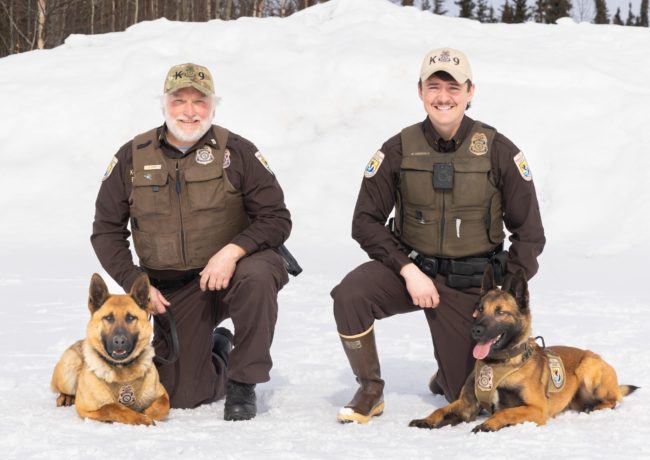By Federal Wildlife Officers/Canine Handlers, Pete Harvey and Robert Barto
Alaska’s Resource Protection Teams: Patrol Captain/ Canine Handler Rob Barto with Eider and Senior Federal Wildlife Officer/ Canine Handler Pete Harvey with Togo. pc. Lisa Hupp
Imagine you are a Federal Wildlife Officer on a very busy National Wildlife Refuge. You just received a call from a concerned citizen stating they heard gunshots near a refuge lake while they were observing nesting migratory birds. The bird watcher stated they saw a huge flock of birds leave their nests as soon as the shots were fired. When the flock cleared, three birds lay motionless on the ground. It was not hunting season.
You respond to the area and try to locate the individuals responsible, but they are gone. So begins your investigation. The large lake is surrounded with high grasses. You follow a trail of flattened down grass to an area where it looks like someone had laid down. You search in vain through the grass to try and locate any shell casings or other evidence. Where do you go from here?
You know that the U.S. Fish and Wildlife Service (USFWS) has nine Resource Protection Canine Teams throughout the country, and one of the teams is located in your area. You call up the team and ask for their assistance.  Eider ready to go to work,. pc: Lisa Hupp
Eider ready to go to work,. pc: Lisa Hupp
This is where Federal Wildlife Canine Togo or Eider and their handlers Peter Harvey and Rob Barto come in. We are certified as Resource Protection Teams. This means Togo and Eider can detect illegally taken wildlife (currently certified in caribou, moose, brown bear and black bear detection), locate evidence of illegal activity (casings, knives, bullet fragments, etc.), track for missing persons, and help apprehend dangerous and violent offenders. Togo and Eider are one of the very few K-9s in the world that are trained for wildlife detection AND handler/public protection.
In this scenario, we would be able to use Togo and Eider’s unique ability to locate “articles” or “evidence” that has human odor. For instance, they would be able to locate any shotgun shells or rifle casings. Both canines are trained to perform a specific function that alerts us to when they have located evidence with human odor. Such evidence could be used in either our or other officer’s investigations.
Both teams are based on the Kenai National Wildlife Refuge but work throughout the state. In addition to the Kenai, the K9s have worked on the Yukon Delta and Tetlin Refuges and assisted the BLM during caribou hunting season along the Steese and Taylor highways. They have participated in search and rescues and duck, moose and caribou hunter law enforcement. In one case with a happy ending, Pete got a call about a hunter harvesting a sub legal moose. Togo was sent out and quickly found the car but the harvested moose turned out to be legal! Both dogs live with their handlers in kennels but not as house pets.
Federal Wildlife Canine Togo was born in the Czech Republic and came to Alaska after training in Pennsylvania. Togo and Pete got to work in August of 2022. Togo got his name from the famous dog team that carried lifesaving medicine to the town of Nome, Alaska, during the 1925 Serum Run. He enjoys being active outdoors, hiking, swimming and eating milk-bones. Federal Wildlife Canine Eider is a four-year-old German Shepard and Belgian Malinois mix. He came from Belarus and was trained in Michigan in 2020. Eider was the first FWS K9 certified for both wildlife detection and handler protection. 
Meet the Dogs
Do you want to see these dogs in action? Come to our indoor/outdoor presentation at the Kachemak Bay Shorebird Festival in Homer, Saturday May 6, 2 pm for adults and 4:30 pm for Junior and Teen Birders. You must register because space is limited, but you can do that online here.
